
Master the Science of Resetting Pleasure in Your Brain and Life
Develop healthy real-life pleasure, starting right now with our support. Use proven effective neuroscientific strategies that address the root issue, brain arousal dysfunction.
Are you anxious, caught up in unwanted screen and sexual behaviors, struggling with sexual arousal dysfunction, your relationships suffering, afraid you you will never be able to feel free again?
With the power of neuroplasticity, there is a formula to reset the pleasure point in your brain.
But, beware: healing is more than just NOT using the screen and explicit matter.
Effective strategies and neuroscience tools are required to overcome the resistance in your hijacked brain to reset the pleasure pathways, such as:
- Urges and Cravings for screen use or explicit matter.
- Unhealthy pleasure sources and habits that pull you back unwantedly.
- Neurological dysfunction that makes you want high levels of pleasure.

Millions of men world-wide are stuck in the never ending loop of pleasure seeking.
Healing from hypersexuality and sexual arousal dysfunction can seem overwhelming, but with a proven approach, healthy pleasure can be achieved much faster than most people realize.
Rewire Your Brain for Healthy Pleasure
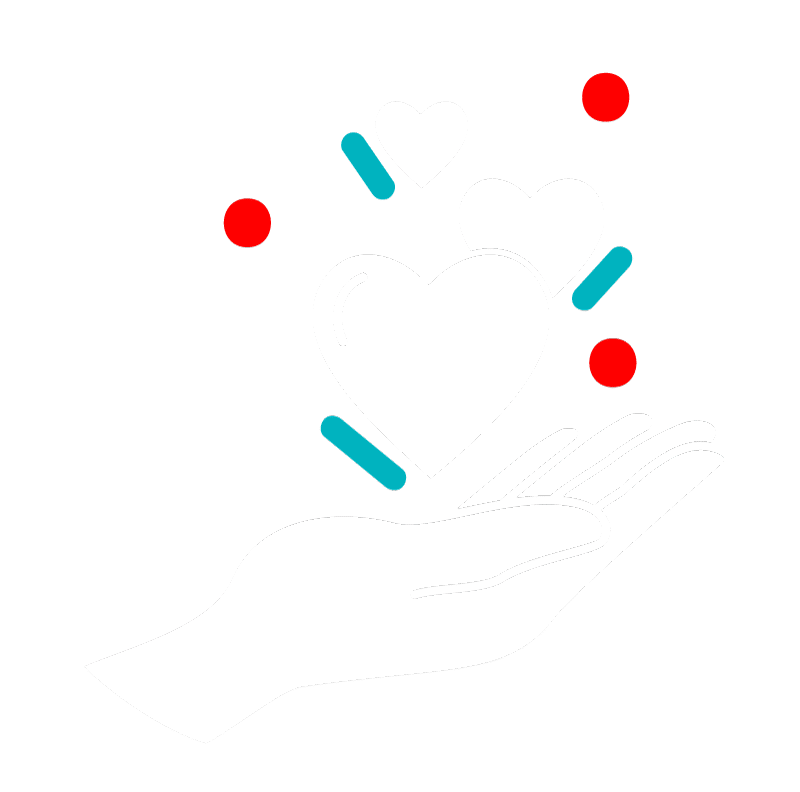
Develop Deeper Intimacy

Achieve Your Full Potential
Dr. Trish Leigh presents to you the most complete masterclass on resetting the pleasure pathways in your brain for healthy screen time and sexuality.
Use a proven system to overcome the pull toward screen time and hypersexuality, reset the pleasure pathways in the brain so you can enjoy your work, hobbies, and relationships again.

What can you expect from this course?
- Proven strategies to resist triggers, unhealthy pleasure levels and sources.
- A Pivot Plan to determine and enjoy pleasure from healthy sources.
- 40-Day Pleasure Reset Plan to implement action steps right away.
- Build healthy sexual arousal with a straightforward action plan.
- Improved emotional regulation skills to control behaviors.
- Brain Training technology lessons to reset pleasure pathways automatically.
- Compassionate and empathetic interpersonal skills to improve intimacy.
- Stress reduction and skills to offset anxiety.
- Strategies, brain hacks, and a plethora of resources to support your reset.
- Support from Dr. Trish Leigh and her team.
Imagine easily refraining from unwanted behaviors that have controlled you for so long. Instead enjoy the activities that you love with the people you enjoy, especially in the bedroom.
- Reset your brain to feel and perform better.
- Improve focus, clarity, confidence, and sexual performance.
- Never go back to porn again.
- Attract and nourish a loving sexual relationship.
At the end of the masterclass you will be equipped to:
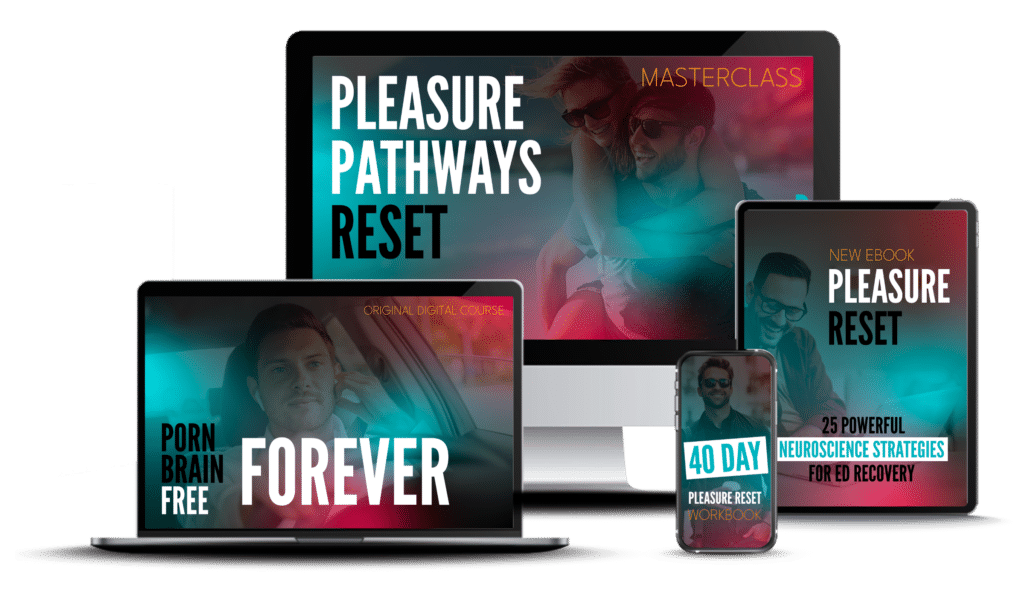
- Live your best life in an authentic creative manner without the need for explicit matter.
- Avoid triggers, physical and mental, back toward screen use and explicit matter.
- Deal with cravings and urges until they subside (which they will as you reset your brain).
- Build healthy pleasure routines into your daily and weekly life.
- Extinguish unwanted habits by understanding how they’ve helped you in the past.
- Increase intimacy using new skills and knowledge.
- Resolve past trauma to release it, unlocking neuroplasticity.
- Create a 90-Day plan of solid action steps to reset pleasure in your brain and life.
- Train your brain at-home using state-of-the-art brain training technology.
- Explore healthy sexuality in new pleasurable and enjoyable ways.
- Balance screen time in a way that will benefit you.
- Establish healthy habits to de-stress and avoid boredom.
- Learn to use the brain’s pleasure seeking to your advantage.
- Benefit from nutritional supplements that can help reset pleasure in your brain.
- Focus with clarity to get in the zone.
- Track progress using advanced at-home technology.
- See your brain improve on graphs and charts as you feel and perform better.
- Enjoy reduced stress levels to feel relaxed and calm through the day.
- Attract a like-minded partner for an engaged relationship that you enjoy.
- Enhance your relationship with your partner through improved communication.
- Fall asleep, stay asleep, and wake up refreshed.
- Eat and exercise to improve your self-control and sexual arousal.
- Succeed at new levels in your work, hobbies, and relationships.
- Empathize compassionately with others for improved relationships.
- Lock in a lifestyle that helps you achieve your goals and full potential.
YES! I want to feel and perform better enjoying real-world pleasure.
Why Does this Method Work?
The difference between a traditional recovery program and resetting the pleasure pathways in your brain is simple.
TRADITIONAL
Recovery Programs
- Limited understanding of the brain’s role in explicit matter and screen addictions.
- Difficulty using your mind and body to stay away from unhealthy pleasure.
- Dependent on weekly meetings to help you stay clean.
- Led by sponsors with some education in recovery.
- Life-long recovery efforts as the pleasure pathways in the brain never fully reset.
Dr. Trish Leigh’s
PLEASURE PATHWAY RESET
- Built on the latest in advanced research of explicit matter and screen addictions.
- Ease of use of proven neuroscience techniques and strategies to reset pleasure in the brain.
- Self-guided, self-paced for immediate access with support from Dr. Trish.
- Created and implemented by Dr. Trish Leigh, leading expert in explicit matter and screen addictions.
- Measurable permanent pleasure reset in the brain as visualized on state-of-the-art, at-home technology.
Reset the pleasure pathways in your brain for long-lasting success to balance screen time, avoid explicit matter, and establish healthy sexuality.
All of this AND more is part of Dr. Trish Leigh’s Program.
OUR MEMBERS SPEAK FOR US
Discover how men like you have lost their fear of addiction, compulsion, and loneliness and have enhanced their real-world pleasure with the Pleasure Pathway Reset Masterclass.
What You Will Learn
Dr. Trish Leigh has created a program of 40 quick but powerful lessons focused on covering the entire pleasure reset process.
Rewire your brain for healthy pleasure, revitalize pleasure from your work and hobbies, establish new habits with healthy pleasure levels and sources, and build real-world intimacy for lasting happiness.
-
MODULE 1:
Pleasure Reset Jumpstart: Build new healthy pleasure pathways while extinguishing old, unhealthy ones
- Switch Pleasure Sources
- Dopamine Stack for Initial Success
- Adjust Pleasure Levels
- Learn from Anger, Irritability, and Urges
- Stop Surviving, Balance Pleasure and Thrive
-
MODULE 2:
Reset Re-directs When You Need it Most: Win Instead of Lose
- Fight Urges & Cravings: Redirect pleasure pathways in times of need
- Limit pleasure to be Limitless (Chaser Effect)
- Forge fantasy to your benefit (healthy fantasy and sexual fantasy)
- Self-soothing: Take the “Longview” before you breakdown
- Why be distracted by pleasure at work and what to do about it?
-
MODULE 3:
Neuromodulation techniques to quicken your results
- Reset your brain without technology
- 3-Minute Brain Resets
- 13-Minutes to Better Choices
- Use a Guide to help you succeed
- Reset your brain WITH technology for faster results
-
MODULE 4:
Expedite Strong Natural Erections to Improve Sexual Satisfaction
- How long does it take to reverse ED and how to do it?
- What about taking a pill?
- Supplements for stronger erections
- Erections, testosterone, and your brain
- Smooth operations for sexual satisfaction
-
MODULE 5:
Learn Delayed Gratification instead of Instant Gratification
- Go Old School to reset pleasure (think Happy Days)
- Easy Button behaviors balanced
- Pleasure Reset Project
- Strive for pleasure
- Arrive for joy
-
MODULE 6:
Pleasure Setpoint & Flow State for Healthy Pleasure
- Focus and Concentrate for pleasure
- Eat for pleasure
- Move for pleasure
- Chill for pleasure
- Fall asleep, Stay Asleep, Wake Up Refreshed
-
MODULE 7:
Use Screens to increase pleasure and joy
- Use screens for your benefit, not your detriment
- Streaming services
- Shorts / Reels / Social Media
- Dating Apps / Messaging
- Explicit Matter
-
MODULE 8:
Authentic Living for long-term success
- Less Stress = More Pleasure
- Beat Boredom
- Relationship dynamics for self-pleasure
- Dare to be You, Dare to be Great
- What to do if you still don’t feel and perform better
PLUS receive your 40-Day Pleasure Reset Plan Workbook
Includes a step-by-step guide to implement pleasure pathways reset in your brain and in your daily routines and habits.
All this and more are included in the Pleasure Pathways Reset Masterclass.
Meet Dr. Trish Leigh
Dr. Trish Leigh knows how to overcome the stronghold that unhealthy pleasure seeking can have on a person’s brain and life.
As a former university professor and a leading Neurofeedback Expert, Dr. Trish has personally helped tens of thousands of people achieve their goals. She is the internationally recognized leading expert on porn addiction recovery and the author of Mind Over Explicit Matter: Quit Porn and Improve Intimacy Through Neuroscience.
Today, she is the CEO of a global impact screen and sex addiction coaching company and creator of her YouTube channel that consistently reaches millions of people each month. Dr. Trish is an influential thought leader on the harms of screen use and explicit matter, rewiring the brain to offset and recover from screen time effects, and ultimately balancing screen time in the context of healthy real-world pleasure, especially relationships.
Dr. Trish has been happily married for almost 25 years and she is the engaged mother of five children. She has made it her mission to live intentionally in every area of her life for authentic, joyful living. She wants that for you too.
Exclusive Bonuses When You Sign Up TODAY.
Take advantage of these additional resources designed to maximize your long-term results in full recovery from porn addiction, compulsive masturbation, and hypersexuality.
Enroll now and benefit from Pleasure Reset: 25 Powerful Neuroscience Strategies for ED Recovery, Dr. Leigh’s newest E-book on quickly recovering from Sexual Arousal Dysfunction and Porn Free Brain Forever, the original 94 lesson course by Dr. Trish Leigh, at NO additional cost.
BONUS #1
Pleasure Reset: 25 Powerful Neuroscience Strategies for ED Recovery (Value $19.99 USD)
This e-Manual is an exclusive offering from Dr. Trish Leigh to answer all your burning questions and quickly learn how to STOP desensitization of the pleasure pathways in your brain and START re-sensitization immediately. This essential guide to recovering from erectile dysfunction and sexual arousal dysfunction is an easy, must-read for anyone struggling with sexual intimacy. Dr. Trish’s most powerful strategies are presented for immediate use.
Join now and jump start your sexual arousal performance with 25 proven effective neuroscience strategies to answer your burning questions.
- Do I have to give up masturbation entirely?
- What about the little blue pill?
- How do I deal with fantasy during intimacy?
- What about unexpected erections?
- Are “vanilla” porn, dating apps, and social media OK to use?
- How long will it take to feel strong and confident again?
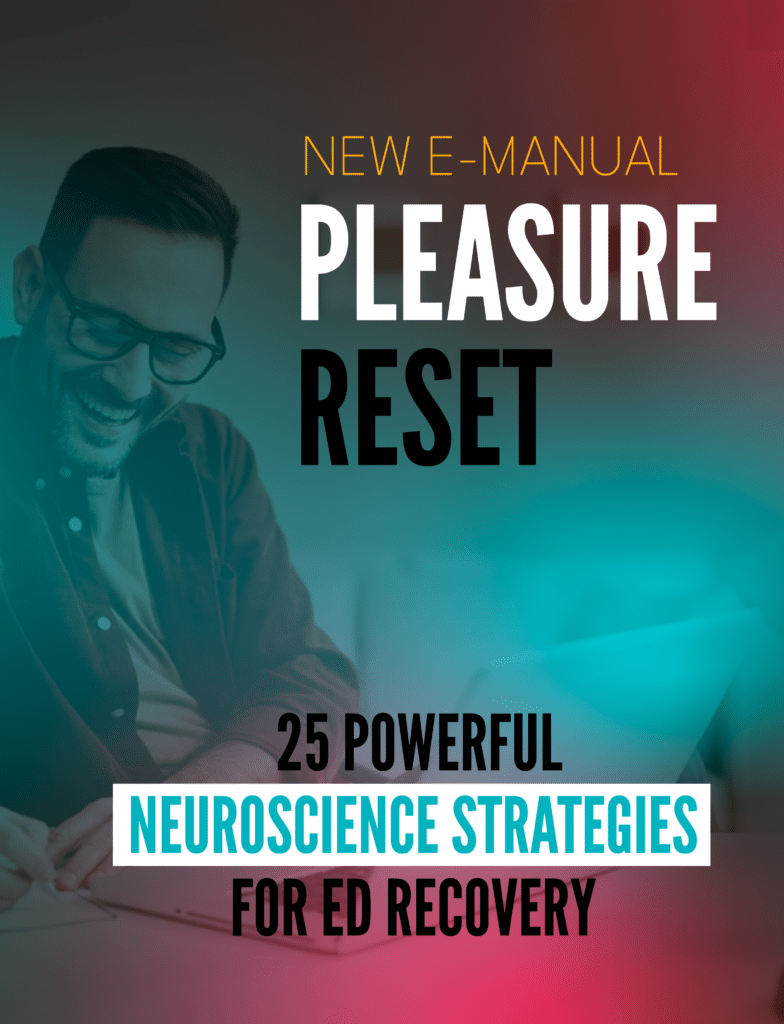
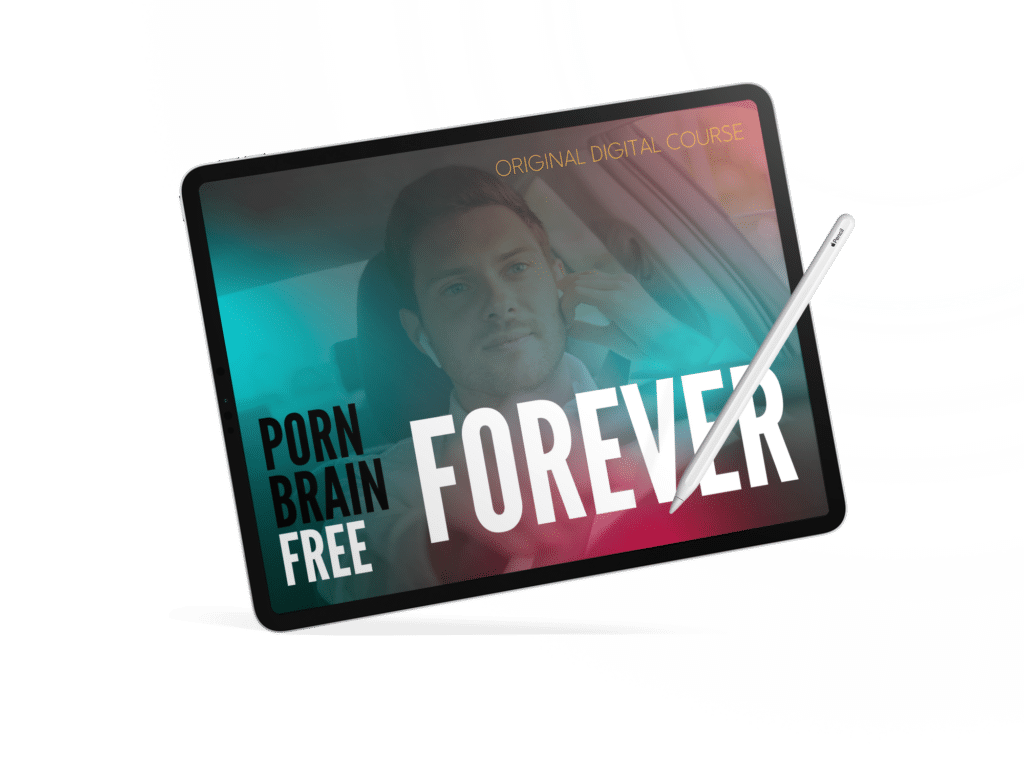
BONUS #2
(and THIS is a HUGE Bonus)
Porn Free Brain Forever: Dr. Trish Leigh’s Original Porn Recovery Program (Value $1199 USD)
Porn Free Brain Forever is the original digital program offered by Dr. Trish Leigh. It has helped thousands of men quit porn, compulsive masturbation, and hypersexuality in all forms. This comprehensive formula teaches you to unwire the need from porn, rewire your brain for healthy pleasure, and hardwire your life for long-term authentic living. Porn Free Brain Forever includes:
-
MODULE 1:
Intro to Porn Brain Rewire, A Holistic Approach
- Lesson 1 - Welcome & Introduction
- Lesson 2 - The Porn Brain Rewire Approach
- Lesson 3 - Integrating Theory With Practice
- Lesson 4 - Addictive Sex vs. Healthy Sex
- Lesson 5 - What You Need to Succeed
-
MODULE 2:
Porn Brain Rewire Essentials
- Lesson 1 - Introduction to Fundamental Concepts
- Lesson 2 - Past, Present, Future
- Lesson 3 - Your Brain's Energy & How It Impacts Your Behavior
- Lesson 4 - How to Un-Wire / Re-Wire / Hard-Wire Your Brain
- Lesson 5 - Regulate From Inside Not Outside
- Lesson 6 - Your Identity? Brain - Mind, Body, Spirit
- Lesson 7 - Your Authentic Self: Who Is It?
- Lesson 8 - Brain Draining vs. Brain Boosting & Brain Neutral - 3 Main States of Being
- Lesson 9 - Improve Emotional Maturity
-
MODULE 3:
Digging into the Past: What Causes Porn Brain & How to Rewire It
- Lesson 1 - Overview of Impact of Past - How it Creates the Hijacker
- Lesson 2 - Trauma, Abuse, Neglect: Impact on The Brain
- Lesson 3 - Family Dysfunction, and Family Systems - Impact on Brain
- Lesson 4 - Personality Type - How it Impacts Your Thoughts and Behaviors
- Lesson 5 - How Your Porn Habit Started (NeuroScience)
- Lesson 6 - Trauma Work Wrap-Up
- Lesson 7 - Review
-
MODULE 4:
Present Porn Brain: Understanding It, Start Rewiring It
- Lesson 1 - 3 Ways You Use Your Brain & How to Include Them in Your Life
- Lesson 2 - Neurological Bases of Porn Use
- Lesson 3 - Your Porn Cycle & How to Break It
- Lesson 4 - Acting Out Behaviors Due to Porn Use & Why
- Lesson 5 - Side Effects of Porn - Which Do You Experience?
- Lesson 6 - Wrap-Up
-
MODULE 5:
How to Stop Watching Porn (Unwire Porn Brain)
- Lesson 1 - Break Shame Cycle
- Lesson 2 - Fences: Complete Porn Brain Defense Plan
- Lesson 3 - Slippery Slope of Behaviors (Danger Zones)
- Lesson 4 - Personalized Pivot Plan & Toolkit
- Lesson 5 - Self-Rewards & Consequences for Behavior for Rebooting Porn Brain
- Lesson 6 - Count or Not to Count
- Lesson 7 - Rough Brain Reboot Day Plan
- Lesson 8 - Cravings & Urges
- Lesson 9 - Withdrawal Symptoms & How to Deal
-
MODULE 6:
Draft Your Offensive Porn Brain Rewire Plan
- Lesson 1 - Intro. to Your Offense Plan
- Lesson 2 - Brain-Boosting Reboot Project "Executive Function (EF) Project"
- Lesson 3 - Flexible Schedule Your Life to Boost Your Brain Power
- Lesson 4 - Brain Boosting Morning Routine
- Lesson 5 - Avoid HALT Plan
- Lesson 6 - Nutrition as Brain Reboot Fuel & Supplement Guide
- Lesson 7 - Exercise for Brain Reboot
- Lesson 8 - Sleep Well to Reboot Your Brain
- Lesson 9- Improve Your Personality, Increase Attraction
-
MODULE 7:
Train Your Brain with Neuromodulation Techniques
- Lesson 1 - Intro. Top-Down & Bottom-Up Approach
- Lesson 2 - Meditation to Heal Your Brain
- Lesson 3 - Neuro-Meditation with Brain Sensing Headband
- Lesson 4 - Home Neurofeedback: Fast Results with Less Effort
- Lesson 5 - Train Your Brain At-Home Guide
- Lesson 6 - Dealing with Stress Everyday
- Lesson 7 - The Brief Resilience Sale
- Lesson 8 - Schedule Personalized Brain Check-in
-
MODULE 8:
Create Healthy Sexuality
- Lesson 1 - Intro. How to Change Your Goal for Sex
- Lesson 2 - Healthy Sexuality, What Is It and How Do You Create It?
- Lesson 3 - Build Intimacy in Your Life
- Lesson 4 - Partnership & Sex Life Reboot Plan
- Lesson 5 - Partner Recovery
- Lesson 6 - No Partner - No Problem
- Lesson 8 - Healthy Masturbation, Fantasy, and Lust Integration Guide
- Lesson 9 - Build Sexual Integrity
- Lesson 10 - Porn, Fantasy, and The Way Back to Reality
- Lesson 11 - Stop Porn Thoughts!
- Lesson 12- Review
-
MODULE 9:
Your Future:Make Your Brain Reboot Stick Permanently
- Lesson 1 - How We are Going to Hard-Wire Your Brain for Lasting Success
- Lesson 2 - Identify Goals to Get You on Purpose
- Lesson 3 - Integration of Personality and How to Avoid Disintegration
- Lesson 4 - Dignity & Integrity - Hard-wired for Permanent Brain Rewire
-
MODULE 10:
Porn Brain Rewire Wrap-Up
- Lesson 1- Add a qEEG Brain Map Assessment
- Lesson 2 - Add Home Neurofeedback for Quick and Easy Results
-
BONUS MODULE:
Rewire Your Relationships With Your Partner & Your Sex Life
- Lesson 1 - Welcome
- Lesson 2 - New Vision of Our Relationship
- Lesson 3 - The Triangle of Relationship Dysfunction
- Lesson 4 - Dr. Jekyll and Mr./Mrs. Hyde
- Lesson 5 - Your Distorted Thought System
- Lesson 6 - The Board Game of Life
- Lesson 7 - Interdependency: What It Is and Isn’t!
- Lesson 8 - Become a Top Tier Partner Because Everyone Wants One
- Lesson 9 - Needs: Healthy or Unhealthy?
- Lesson 10 - Rebuild Trust
- Lesson 11 - Let’s Talk About Sex!
- Lesson 12 - Relationship Rewire Wrap Up
-
BONUS MODULE:
Arousal & Erectile Dysfunction Rewire
- Lesson 1 - Healthy Arousal
- Lesson 2 - Healthy Erections
- Lesson 3 - Healthy Sex Life
- Lesson 5 - Erectile Dysfunction
- Lesson 6 - Delayed Ejaculation & Premature Ejaculation
- Lesson 7 - Rewire Arousal
- Lesson 8 - Subconscious and Conscious Rewire
- Lesson 9 - Nitric Oxide for Cellular Rewire
- Lesson 10 - Harder Erections: Understanding Erectile Dysfunction Mechanics
- Lesson 11 - Wrap Up
Get your bonuses now!
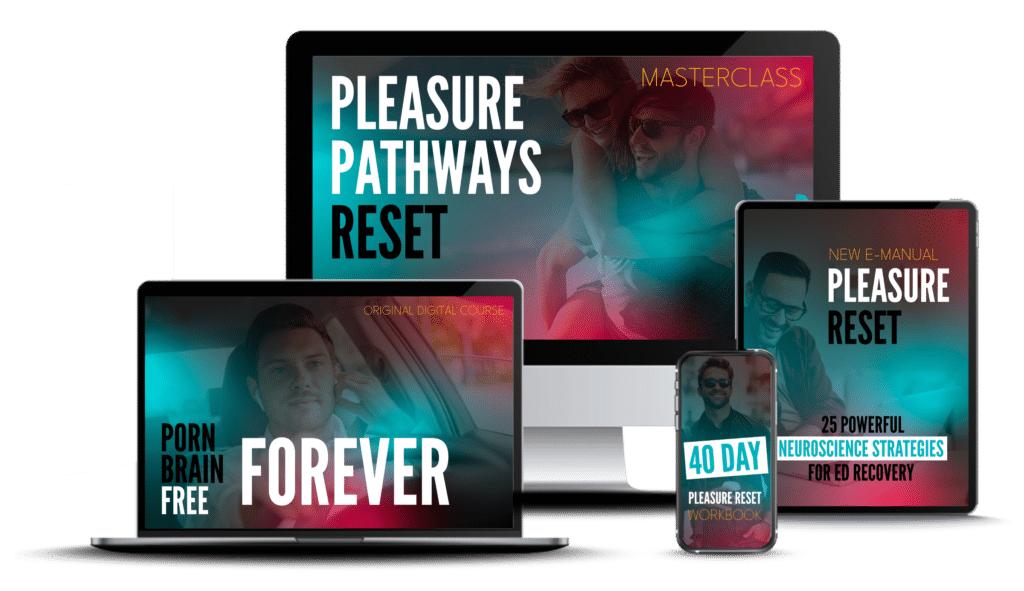
Reset Your Pleasure Pathways TODAY.
- Online Pleasure Pathways Reset Masterclass with 8 essential strategies in 40 quick-start lessons to leave unhealthy pleasure levels and sources so you can build lasting healthy real-life pleasure and happiness.
- 94 complete lessons on recovering from porn use, compulsive masturbation, and hypersexuality of all kinds.
- Theory and practice of all strategies for long-lasting results.
- 40-Day downloadable workbook to implement action steps immediately.
- ED Reset Guide of 25 neuroscience strategies to quickly jumpstart healthy sexual arousal.
- Sexual Arousal Questions answered with our exclusive guide.
- Exclusive private support group with Dr. Trish Leigh.
- Bonus Downloadable E-Manual Pleasure Reset: 25 Powerful Neuroscience Strategies for ED Recovery (Value $19.99 USD).
- Bonus Porn Free Brain Forever original Dr. Trish Leigh digital program for lasting success. (Value $1199 USD).
All this is included in Dr. Trish Leigh’s Program
Is your brain wired for pleasure from screen and explicit matter?
Now it is time to reset the pleasure pathways back toward your work, relationships, and hobbies.
Your unwanted behaviors keep you stuck going back for more and more pleasure from the screen and hypersexuality. Now is the time to release yourself from self-soothing with porn, masturbation, explicit matter, and excessive screen time.

How can you create a life you love as the best version of yourself?
The solution is simple: healthy pleasure in your brain and lifestyle.
- The Pleasure Pathways Reset Masterclass rewires the brain’s neural pathways for pleasure, joy, peace, and connection leading you toward the life that you have always wanted and deserve.
- Whether you have struggled with porn addiction, masturbation compulsion, screen addiction or hypersexuality for years or decades, you are in the right place. It is time for a Pleasure Pathways Reset.

The Pleasure Pathways Reset Masterclass contains the eight best strategies from Dr. Trish Leigh.
As one of the world’s leading experts on porn and screen addictions and the author of Mind Over Explicit Matter, the gold-standard guide for porn addiction recovery, Dr. Trish Leigh uses neuroscience tools, technology, and strategies to help people overcome screen and sexual addictions and get results faster.
In her 25+ year career, Dr. Trish Leigh has developed eight essential strategies for resetting the brain’s reward system to unlink it from unhealthy behaviors and rewire it to desire and enjoy all aspects of a healthy lifestyle, including an amazing sex life.
- Weed the old pathways and start forging new ones.
- Redirect pleasure seeking toward your life.
- Harness the daily power of dopamine.
- Improve your brain performance using advanced (and safe) technology.
- Restore joy, peace, and connection.
- Invigorate motivation, determination, and persistence.
- Establish healthy arousal levels for improved intimacy.
- Balance stress for long-term success.

CREATE a 40-Day Pleasure Reset Plan
The Pleasure Pathways Reset Masterclass is about implementation more than anything.
Once you have learned the eight pleasure reset strategies within 40 quick-start lessons, you’ll immediately put them to use with a 40-Day Pleasure Reset Plan. This is a custom, actionable game plan to help you achieve your biggest goals in the next 40 days.
After just 40 days you will feel and perform better.
Imagine what you can accomplish from having 40 full days of pleasure pathways resetting with strong tools and strategies.
Move from being stuck or making slow incremental progress to life-changing gains.
Leverage Real-Life Pleasure to ENHANCE YOUR LIFE
Now it is time to reset the pleasure pathways back toward your work, relationships, and hobbies.

8 Core Modules of 40 Quick-Start Action Steps + 94 Comprehensive Actionable Lessons
We’ve compressed our revolutionary framework into just 8 modules of 40 quick and easy action steps so you can reset your pleasure pathways in only a few hours. Then you can dive deep into our original 94 lesson program for lasting success.

Proprietary tools you can use instantly.

Learn anywhere, anytime, on any device.
Your time is limited. Sometimes the only moments you can afford are when you are traveling in your car. This is why Dr. Trish Leigh has designed this course to be learned anywhere, anytime – screen or no screen.

A repeatable proven system for reinforcing healthy pleasure pathways for the rest of your life.
Once you master this framework, you will know a repeatable strategy for achieving healthy pleasure, happiness, connection, and relationship intimacy for long-term results over time.

A 40-Day Pleasure Reset Plan.
This plan will help you turn the principles from the masterclass into tangible action steps.
Do you have any QUESTIONS?
Find the answers to the most common questions and discover how our masterclass can transform pleasure in your life.
What’s Included in the Pleasure Pathways Reset Masterclass
When you register for the Pleasure Pathways Reset Masterclass, you will immediately have full access to eight core modules of forty quick-start action steps that teach you the entire framework for eliminating unhealthy pleasure from screens and explicit matter. You will also receive a workbook with exercises for the eight scientifically-proven tools you can use to reset your brain for healthy pleasure. Exclusive bonuses are available now that include Dr. Trish Leigh’s e-book on ED recovery and the original ninety-four lesson Porn Free Brain Forever program.
Where did this framework come from?
The Pleasure Pathways Reset framework was built exclusively by Dr. Trish Leigh from the latest discoveries and modern research surrounding neuroscience, screen addiction, sex addiction, relationship satisfaction, and self actualization. Tens of thousands of clients have experienced transformation through these tools and strategies. With Pleasure Pathways Reset, Dr. Trish has taken only the top-tier action steps and put them inside the eight-part framework for quick and easy implementation of change.
You can trust you are getting the most updated and ground-breaking content to upgrade the pleasure pathways in your brain and life.
What makes Pleasure Pathways Reset different from Porn Free Brain Forever digital program?
Pleasure Pathways Reset builds on the most powerful insights from Porn Free Brain Forever but clarifies them to focus on unhealthy pleasure sources of all kinds including excessive screen time, social media, and explicit matter in all forms. It also strongly investigates the arousal dysfunctions caused by these sources and provides clear and concise action steps to immediately reset the brain for healthy pleasure from real-world sources.
Porn Free Brain Forever is a much deeper dive into the neuroscience behind porn addiction and compulsive masturbation and offers a large, comprehensive strategy of complete lessons. This overarching formula is important to have but takes longer to learn. That is why Dr. Trish is including Porn Free Brain Forever in the Pleasure Pathways Reset Masterclass bundle. This way you can get started quickly but also learn to implement all the principles that are necessary for lasting change.
I don’t have much time available, can I progress at my own pace?
Yes, this masterclass is designed to be flexible. You can progress at your own pace and each lesson is structured into short capsules to facilitate learning at any time you have available.
Will these strategies work for my unique situation?
Yes, the neuroscience strategies included in this masterclass are adaptable to any unwanted high pleasure activity focusing on screen time and explicit matter use. We also offer support from specialized coaches within the program to help you apply the techniques to your specific context, ensuring their effectiveness.
Do I need to have other local professional help to benefit from this course?
No prior experience in recovery or other types of professional help are required. The masterclass covers everything from the basics concepts to advanced strategies, explained in a simple and accessible way by Dr. Trish Leigh so that anyone can follow it.
How can I be sure that this course is effective?
The masterclass is based on proven and validated methodologies that have helped thousands of people escape unhealthy pleasure from screen use and explicit matter. It includes real examples and success stories so you can see how the strategies are implemented.
What kind of support will I receive during the course?
You will have access to Dr. Trish Leigh, specialized coaches, and a support community to answer your questions and accompany you in your learning process, ensuring that you apply the strategies effectively.
Is the course content up to date?
Yes, this course is created by Dr. Trish Leigh based on the most up to date research while she contributes her 25+ years experience to the explanations. Dr. Trish continually updates the material to reflect new scientific findings and strategies ensuring the highest level content.
Is this course focused solely on pornography addiction?
Explicit Matter of all types, especially porn, are the primary sources of unhealthy screen time pleasure, so there is a strong emphasis on those topics. However, this program has been taken by many men who struggle with gaming, excessive screen time use in general, in addition to those who struggle with sex addiction, infidelity, lusting, and erectile dysfunction from unknown sources.
I have taken other courses and have not seen results, what makes this course different?
This course is different because it is based on proven neuroscience tools and strategies and it is created and delivered by one of the foremost experts in the world on screen and explicit matter recovery, Dr. Trish Leigh. It includes practical exercises at three different levels that will allow you to implement what you have learned immediately to see quick results, while reinforcing the theory and action steps in a more comprehensive manner for long-term success.
How long will I have access to the masterclass?
You will have access to the Pleasure Pathways Reset Masterclass for one year. This time frame is set on purpose by Dr. Trish. Without a reasonable deadline, your hijacked brain may prevent you from starting and finishing this program. You will, of course, have your workbook and exclusive e-book as long-term resources to solidify your initial learning.
Can I take this course if I am a woman?
Yes, this masterclass is designed for the millions of men struggling with unwanted screen and sexual behaviors but also addresses the increase in women who are falling victim to the high pleasure levels involved.
Should I make extra investments?
Most of the tools that are suggested are free of charge. This way you have an all-inclusive program within the masterclass. There will be few suggestions for technologies and services that do include additional investments and if you want to get the most out of resetting your brain for healthy pleasure these tools can be a game-changer for strong results in a faster time frame. If you want to accelerate your gains, the most logical thing to do is invest in your initial recovery efforts.

Pleasure Pathways Reset is for those who want…
- Freedom from explicit matter and excessive screen use.
- Improve sexual arousal function and satisfaction.
- Increase productivity, focus, and clarity.
- Enhance relationship quality, communication, and intimacy.
… This program is especially for anyone struggling with the secrecy of pornography addiction and erectile dysfunction.
This program is designed for you.


